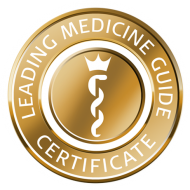Was unsere Patienten sagen
Rekord Zeckenjahr – Kinderwunschexperte rät zur Impfung
Besonders penibel muss auf mögliche negative Auswirkungen bei der Einnahme von Medikamente oder auch Impfstoffen aufgepasst werden. Aufgrund des milden Winters ist 2020 ein besonders starkes Zeckenjahr und vielen werdenden Müttern und Kinderwunschfrauen stellt sich nun die Frage, ob eine Zeckenimpfung einen negativen Einfluss auf die Schwangerschaft hat.Frauen mit Kinderwunsch sollten sich möglichst vor der Schwangerschaft über ihren Impfstatus erkundigen. Gerade in den letzten zwei Monaten haben viele Österreicherinnen und Österreicher ihre Liebe zur Natur und Outdooraktivitäten wiederentdeckt, viele sind sich jedoch nicht des Risikos eines Zeckenbisses bewusst. Abgesehen von dem unappetitlichen Fakt einen Parasiten auf sich sitzen zu haben können Zecken auch die lebensbedrohliche Gehirnhautentzündung FSME und Borreliose übertragen. Wenn die letzte FSME Impfung fünf oder mehr Jahre her ist sollten sich Frauen impfen lassen, um in der Schwangerschaft einen Schutz für sich und ihr Baby zu haben. Sollte kein Impfschutz bestehen und die Schwangerschaft ist bereits eingetreten wurde zwar bisher kein negativer Effekt einer FSME Impfung in der Schwangerschaft beobachtet, aus Sicherheitsgründen sollte jedoch nicht im ersten Drittel der Schwangerschaft FSME geimpft werden – nach dem ersten Trimenon und in der Stillzeit gibt es jedoch keine Bedenken.Auch wenn ein Impfschutz gegen FSME besteht sollte nach jedem Spaziergang eine Selbstuntersuchung des Körpers auf Zecken stattfinden, da Zecken auch Borreliose übertragen können, wogegen leider noch kein Impfstoff existiert.Späte Mütter zeugen kinderlose Töchter
Der verspätete Kinderwunsch kann allerdings auch direkte und indirekte Effekte auf Folgegenerationen haben. Bereits mehrere Studien konnten anhand von historischen Kohorten in Finnland und Kanada aus dem 18. und 19. Jahrhundert nachweisen, dass ältere Mütter eher kinderlose Töchter hatten (Smits et al., 1999, Gillespie et al., 2013). In einer rezenten Studie wurden 43.135 Amerikanerinnen untersucht und ihre Familiengeschichte erhoben (Basso et al., 2018). Die vorliegende Studie konnte mit steigendem mütterlichem Alter dieser Patientinnen eine konstante Zunahme der Kinderlosigkeit feststellen.Das bedeutet, ältere Mütter hatten mit höherer Wahrscheinlichkeit kinderlose Töchter. Trotzdem gaben Töchter von älteren Müttern vergleichbare Angaben bezüglich einer ungewollten Kinderlosigkeit über 1 Jahr an, was einen biologischen Mechanismus der Kinderlosigkeit unwahrscheinlich erscheinen lässt. Andere Faktoren die mit Kinderlosigkeit vergesellschaftet waren, sind höhere elterliche Ausbildung, weniger Geschwister sowie eine erstgeborene Tochter zu sein.Töchter von älteren Frauen zeigten außerdem eine Tendenz selbst höher gebildet zu sein und unverheiratet zu bleiben. Auch in der multivariablen Analyse, welche diese, mit Infertilität assoziierte Faktoren berücksichtigt hat blieb der Effekt des maternalen Alters auf die Infertilität der Töchter konstant. Auch wenn die vorliegende Studie nicht auf biologische Faktoren der Kinderlosigkeit der Folgegeneration hindeutet und diese auch nicht untersucht, kann ein genetischer bzw. epigenetischer Faktor der Kinderlosigkeit nicht ganz ausgeschlossen werden.Quellen:
BASSO, O., WEINBERG, C. R., D'ALOISIO, A. A. & SANDLER, D. P. 2018. Maternal age at birth and daughters' subsequent childlessness. Hum Reprod, 33, 311-319.GILLESPIE, D. O., RUSSELL, A. F. & LUMMAA, V. 2013. The effect of maternal age and reproductive history on offspring survival and lifetime reproduction in preindustrial humans. Evolution, 67, 1964-74.
SMITS, L., ZIELHUIS, G., JONGBLOET, P. & BOUCHARD, G. 1999. The association of birth interval, maternal age and season of birth with the fertility of daughters: a retrospective cohort study based on family reconstitutions from nineteenth and early twentieth century Quebec. Paediatr Perinat Epidemiol, 13, 408-20.
Super Betreuung
Das ganze Team war stets sehr hilfsbereit und sehr freundlich. Wir haben uns sehr aufgehoben gefühlt.Neue Studie gibt Entwarnung: Eizellen COVID-frei
Abgesehen von den allgemeinen Auswirkungen auf die Gesundheit herrscht noch immer Unklarheit ob – und wie COVID von der Mutter oder vom Vater auch auf die Keimzellen und folglich auf den Embryo übertragen wird. „In der täglichen Praxis hatten wir im letzten halben Jahr immer wieder Paare gehabt, welche sich kurz nach bzw. vor Eintritt einer Schwangerschaft mit dem Coronavirus angesteckt haben und in weiterer Folge die Schwangerschaft verloren haben. Zwangsläufig stellt sich dann die Frage ob die COVID Infektion die Ursache für den negativen Schwangerschaftstest oder die Fehlgeburt ist.Mehrere Studien konnten bereits Coronaviren in der Samenflüssigkeit von erkrankten Männern feststellen. Eine soeben erschienene Studie untersuchte, ob Coronaviren auch auf Eizellen von mit Corona infizierten Frauen gefunden werden können. Die spanische Studie untersuchte hierfür 16 Eizellen von zwei SARS-Cov-19 erkrankten Frauen. In keiner der Eizellen konnte das Virus nachgewiesen werden. Somit scheint zumindest eine rund um den Eisprung auftretende mütterliche COVID Infektion sich nicht auf den Embryo zu übertragen. Die soeben publizierten Daten müssen jedoch mit Vorsicht interpretiert werden, da es sich lediglich um zwei Frauen handelte deren Eizellen untersucht wurden. Außerdem könnte sich einer länger andauernde mütterliche COVID Infektion in weiterer Folge auf die Einnistung des Embryos negativ auswirken.1. Barragan M, Guillen JJ, Martin-Palomino N, Rodriguez A, Vassena R. Undetectable viral RNA in oocytes from SARS-CoV-2 positive women. Hum Reprod. 2020Liebes Wunschbaby Team!
Herzlichen Dank für die einfühlsame und sehr professionelle Betreuung! Wir waren in den besten Händen! Familie K.Lesen Sie mehr

Homologous Intrauterine Insemination
The artificial introduction of the semen into the uterus.
The goal of light hormonal therapy is to stimulate the growth of 1-2 follicles. Follicular maturation and the continued growth of the uterine lining is monitored per ultrasound. Based on the size of the follicles, the thickness of the uterus lining, and through ovulation tests, the point of ovulation can be predicted. In most cases, ovulation is medically induced once the follicles have achieved a certain size – providing the best time for the insemination.
The semen obtained for IUI (through masturbation) is prepared in the laboratory and then inserted into the female’s uterus through the cervix using a thin, flexible plastic tube called a catheter.
In most cases, this procedure does not cause any complications, pain, or discomfort.
By providing the sperm with a "shortcut” on the route that they would naturally have to conquer in order to fertilize the egg, the primary goal of this method is to increase the probability of conception. The chance of becoming pregnant with this method is approximately 15-20% per cycle.
- Overview
- IVF
- IVF in 10 steps
- Cause of miscarriages
- Assisted-Hatching
- Chipsi
- Application of Seminal Plasma
- Egg cell donation
- Genetics
- Testicular puncture
- Insemination
- ICSI
- Fertility treatment in same-sex couples
- The dream to have children despite cancer
- Complementary Medicine
- Cryopreservation
- Male Infertility
- PICSI
- Psychotherapeutic support
- Sperm and egg cell donations
- Social Freezing



































